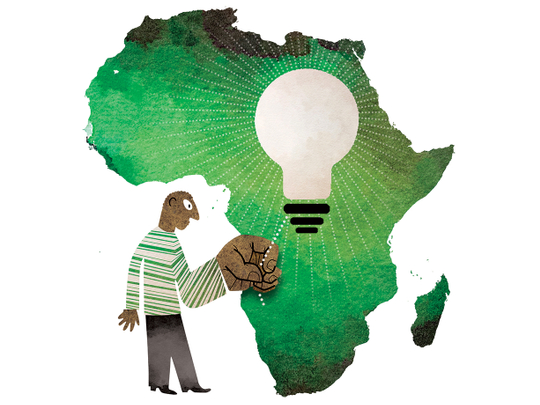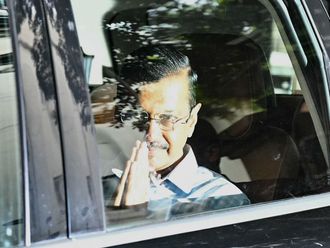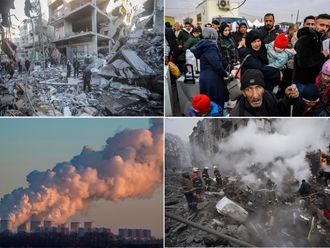
You can’t create a modern economy without access to energy, and lots of it. Energy to run mills and mines, to grow and process food, to light up markets, to build roads and factories, or to build machines that can build more machines. So it’s no coincidence that the average African (excluding South Africa) earns a per capita income about 88 times lower than an average American and uses about one-87th the amount of energy. Maybe it’s time for Africans to get more energy?
With United States President Barack Obama’s launch of the Power Africa initiative in 2013 and the new Electrify Africa bill passed by the US Congress on February 1 (that’s right — Congress got something done, and it was a foreign aid bill, no less), the prospect of electrifying Africa has once again galvanised the development community. Power Africa is an umbrella initiative that has, in the past two years, generated over $30 billion (Dh110.34 billion) in investment commitments from partners seeking to dramatically increase both the number of megawatts produced (30,000 more by 2020) as well as the number of people who can now access that power to an additional 60 million. What the Electrify Africa Act does: It essentially gives bipartisan support to these goals, and calls for a plan to reach them. It makes the effort a congressionally authorised one. While it doesn’t appropriate any funds directly, it reinforces support for Power Africa in the budget process.
All this action is resulting in real wattage on the ground. Data from a new Power Africa Roadmap, released on January 28, 2016, shows projects in the offing that would add two-thirds of the promised megawattage. Countries like Kenya, which added over two million connections in the last few years, are going gangbusters. In 2010, only five per cent, or about 1.7 million of the 34 million Kenyans in rural areas, had access to energy. These recent gains have more than doubled that number. But you only need to look at this great night-time Nasa satellite image to remember that there are many reasons why Africa still sits in the dark, and a vast array of challenges that prevent that picture from changing soon.
This big idea, it turns out, is not new. The United Nations’ plan for the “First Development Decade”, from 1961 to 1970, prioritised energy investment to help industrialise the newly decolonised continent and boost economic growth. This spawned the creation of new institutions like the African Development Bank to finance these plans. Dams were built, utilities were created and lines were strung, as hundreds of millions of Africans got (often unreliable) access to energy. But most didn’t, thanks to weak institutions, corruption, unpaid debt, and low investor confidence, and perpetual conflict. Major donors mostly turned to other challenges: Vaccinating and educating children, improving agriculture, making micro loans to women to start small enterprises.
The enthusiasm for powering Africa is not just in the United States. In Davos last month, the African Development Bank launched its Rooseveltian “New Deal on Energy for Africa”, promising to double energy production and triple access in Africa over the next decade. The EU announced a new (if poorly spelled) ElectriFI initiative, backed by a few billion euros and the UN-created Sustainable Energy for All initiative. Indeed, the brand-spanking-new global development goals, agreed to by 193 nations at the UN last autumn, include a goal that promises universal “access to affordable, reliable, sustainable, and modern” energy by 2030. While everyone may be counting some of the same megawatts or huts with solar panels in these overlapping initiatives, the overall impact of achieving these goals would be immense, however you count them.
It’s nice when everyone agrees. Africa needs more energy and more people across the continent with more access to it to spur inclusive growth — the kind needed to address poverty, exclusion, and ethnic and gender discrimination. Not only is Africa power-starved, but seven in 10 people in sub-Saharan Africa have no access to energy at all. No lights to study by, refrigerators for milk and vaccines, fans for the summer, or computers to cross the vast digital divide.
With the needs so obvious and crucial, it’s perhaps confounding that African governments and the international development community have failed, repeatedly, to rally the public and private will to electrify Africa. As it turns out, there are a number of explanations.
My Political Science friends might call this a “collective action problem”, a fancy way of saying it’s hard to do things when they require consensus among a range of people with different incentives. The US, for example, is currently funding a feasibility study for a solar power plant in northern Nigeria. To make this plant a reality, a state government — charged with addressing security issues along with massive development challenges — a federal government, an electricity regulator, a distribution company, a private sector generation company and its financing partners, along with the affected households, businesses, and landowners, must work in concert. And will the price for electricity be the same for solar as oil, (which has been subsidised for decades)? For the north and south? Governments fall over things like the cost of power.
The law and governance crowd, on the other hand, see “predatory” regulation or institutions everywhere — in other words, the people who have a monopoly on selling power like to keep it that way, or just don’t have the wherewithal or knowledge to manage or change it. In Liberia, for example, a plan to jump-start new energy investment and rehabilitate the Mt. Coffee hydropower plant repeatedly stalled, due to failures to pass legislation allowing for the investment and to establish a regulatory board, even before the nation-wide setbacks due to the Ebola contagion.
The finance folks, meanwhile, prefer to blame “risk allocation” — the possibility that their investments won’t pan out or will go up in smoke altogether. Building power plants is expensive, and if they use the wrong type of fuel (sorry — coal), terribly polluting, which comes with its own (too often hidden) costs. For example, while most international investors offer dollars and expect dollars in return, power bills are paid in local currency. At worst, currency exchange fluctuations can wipe out profits, or, at best, make long term planning challenging.
They are all, of course, right — at least from their own perspective. That brings us back to the collective-action problem.
So what’s different this time? There are some strong winds of change blowing in the right direction — some powering wind farms, even. First, the aforementioned initiatives proactively address the collective action problem. Pretty much every major development finance institution and many large banks and energy companies are getting into the game. Power Africa counts over 100 energy companies and finance institutions as partners. Last year, Citi Bank and SMBC worked with the OECD, World Economic Forum, the United States, Sweden, and other partners, to launch a $100 billion Sustainable Development Investment Partnership to develop infrastructure in emerging markets. It’s not just the money — although that’s needed — but the relentless commitment to overcome past the hurdles.
African governments are not only placing power at the top of their priority lists, but are passing important reforms to allow energy investment to flourish. The notoriously private-sector phobic Ethiopian regime, for one, recently agreed to its first-ever deal to purchase power from a private developer, without which investment wouldn’t happen. And South African officials like Karen Breytenbach, who visited Washington recently for a Power Africa summit, have been lauded for directing their country’s energy investments towards renewables, paving a path for other reformers.
Meanwhile, the world is undergoing a renewable-energy revolution that’s already registered a major impact in Africa. Low-cost solar panels are lighting hundreds of thousands of homes in villages that won’t be connected to central power grids for years, if ever. The increasingly potent efforts to forestall climate change, like the December Paris climate agreement, will be backed by public subsidies to help make sure Africa’s power infrastructure is less polluting than ours. Google, Tesla, and Facebook, are all investing in renewable energy research and projects directed at Africa (and the means to get more people onto their websites and buying their batteries).
While wars, corruption, unstable currencies and fickle donors are all still to be found in Africa, there are potent forces for change at work today: Presidential leadership, a bi-partisan bill, a global goal, local leadership, a lot more money, more stakeholders trying to remove barriers than create them. No one factor can change the prospects that hundreds of millions who’ve never owned so much as a light bulb will soon be hitting the switch. But when combined, these pieces coming together may very well tip the balance towards a brighter future for Africa.
— Foreign Policy/New York TimesNews Service
Alex Thier is founder of Triple Helix, a strategic consulting firm and a former senior official at the US Agency for International Development from 2010 to 2015.



_resources1_16a45059ca3_small.jpg)






